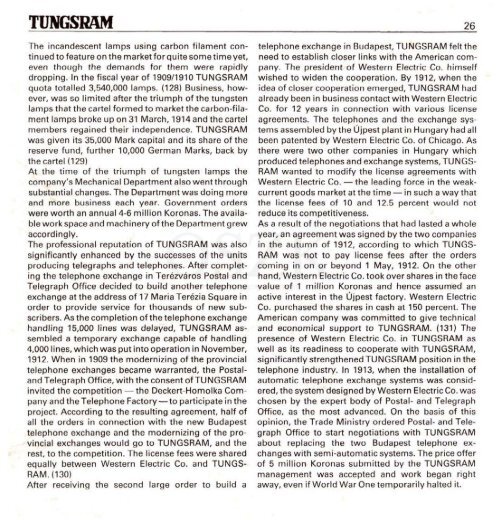THE HISTORY OF TUNGSRAM 1896-1945 - MEK
THE HISTORY OF TUNGSRAM 1896-1945 - MEK
THE HISTORY OF TUNGSRAM 1896-1945 - MEK
- No tags were found...
You also want an ePaper? Increase the reach of your titles
YUMPU automatically turns print PDFs into web optimized ePapers that Google loves.
<strong>TUNGSRAM</strong>• > . ^26The incandescent lamps using carbon filament continuedto feature on the market for quite some time yet,even though the demands for them were rapidlydropping. In the fiscal year of 1909/1910 <strong>TUNGSRAM</strong>quota totalled 3,540,000 lamps. (128) Business, however,was so limited after the triumph of the tungstenlamps that the cartel formed to market the carbon-filamentlamps broke upon 31 March, 1914and the cartelmembers regained their independence. <strong>TUNGSRAM</strong>was given its 35,000 Mark capital and its share of thereserve fund, further 10,000 German Marks, back by•v the cartel (129)At the time of the triumph of tungsten lamps thecompany's Mechanical Department also wentthroughsubstantial changes. The Department was doing moreand more business each year. Government orderswere worth an annual 4-6 million Koronas. The availablework space and machinery of the Department grewaccordingly.The professional reputation of <strong>TUNGSRAM</strong> was alsosignificantly enhanced by the successes of the unitsproducing telegraphs and telephones. After complet-.'• ing the telephone exchange in Terezvaros Postal andTelegraph Office decided to build another telephone>" exchange at the address of 17 Maria Terezia Square inorder to provide service for thousands of new sub-' scribers. As the completion of thetelephone exchangehandling 15,000 lines was delayed, <strong>TUNGSRAM</strong> assembleda temporary exchange capable of handling4,000 lines, which was put into operation in November,1912. When in 1909 the modernizing of the provincialtelephone exchanges became warranted, the PostalandTelegraph Office, with the consent of <strong>TUNGSRAM</strong>invited the competition — the Deckert-Homolka Companyand the Telephone Factory — to participate in theproject. According to the resulting agreement, half ofall the orders in connection with the new Budapesttelephone exchange and the modernizing of the provincialexchanges would go to <strong>TUNGSRAM</strong>, and therest, to the competition. The license fees were sharedequally between Western Electric Co. and TUNGSRAM. (130)After receiving the second large order to build atelephone exchange in Budapest, <strong>TUNGSRAM</strong> felt theneed to establish closer links with the American company.The president of Western Electric Co. himselfwished to widen the cooperation. By 1912, when the *idea of closer cooperation emerged, <strong>TUNGSRAM</strong> hadalready been in business contact with Western ElectricCo. for 12 years in connection with various licenseagreements. The telephones and the exchange systemsassembled by the Ujpest plant in Hungary had allbeen patented by Western Electric Co. of Chicago. Asthere were two other companies in Hungary whichproduced telephones and exchange systems, TUNGSRAM wanted to modify the license agreements withWestern Electric Co. — the leading force in the weakcurrentgoods market at the time — in such a way thatthe license fees of 10 and 12.5 percent would notreduce its competitiveness.As a result of the negotiations that had lasted a wholeyear, an agreement was signed by the two companiesin the autumn of 1912, according to which TUNGSRAM was not to pay license fees after the orderscoming in on or beyond 1 May, 1912. On the otherhand. Western Electric Co. took over shares in the facevalue of 1 million Koronas and hence assumed anactive interest in the Ujpest factory. Western Electric ^^-Co. purchased the shares in cash at 150 percent. TheAmerican company was committed to give technicaland economical support to <strong>TUNGSRAM</strong>. (131) Thepresence of Western Electric Co. in <strong>TUNGSRAM</strong> aswell as its readiness to cooperate with <strong>TUNGSRAM</strong>,significantly strengthened <strong>TUNGSRAM</strong> position in thetelephone industry. In 1913, when the installation ofautomatic telephone exchange systems was considered,the system designed by Western Electric Co. waschosen by the expert body of Postal- and TelegraphOffice, as the most advanced. On the basis of thisopinion, the Trade Ministry ordered Postal- and TelegraphOffice to start negotiations with <strong>TUNGSRAM</strong>about replacing the two Budapest telephone exchangeswith semi-automatic systems. The price offerof 5 million Koronas submitted by the <strong>TUNGSRAM</strong>management was accepted and work began rightaway, even if World War One temporarily halted it.• • . .. I








![Letöltés egy fájlban [4.3 MB - PDF]](https://img.yumpu.com/50159926/1/180x260/letaltacs-egy-fajlban-43-mb-pdf.jpg?quality=85)







